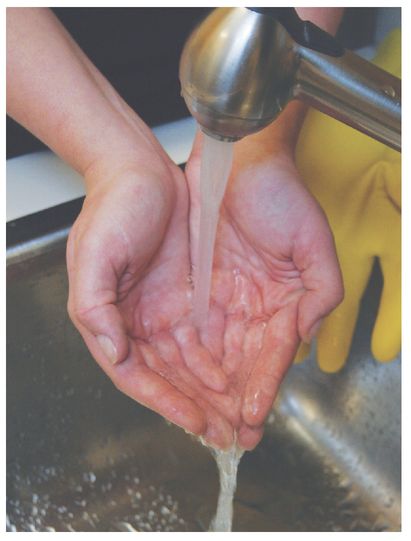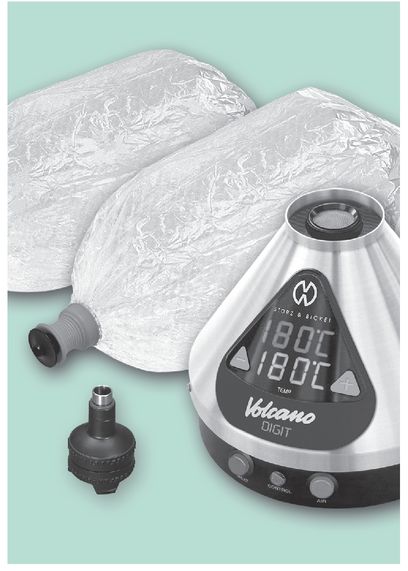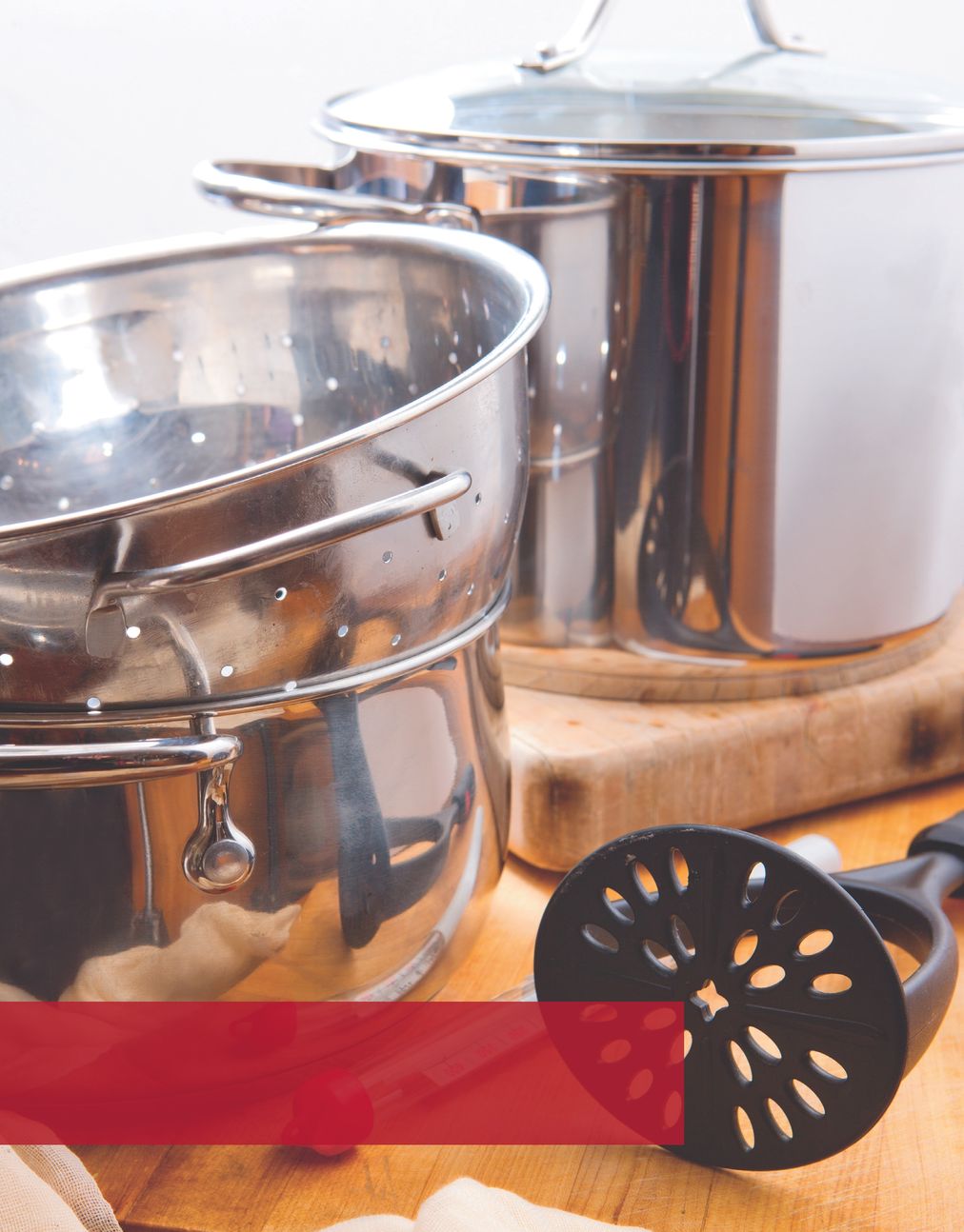Aunt Sandy's Medical Marijuana Cookbook (4 page)
Read Aunt Sandy's Medical Marijuana Cookbook Online
Authors: Sandy Moriarty
DISEASES AND PATHOGENS
 SAFETY EQUIPMENT
SAFETY EQUIPMENT

 CONTROLLING THE MEDICINAL POTENCY OF MARIJUANA FOODS
CONTROLLING THE MEDICINAL POTENCY OF MARIJUANA FOODS
Marijuana is a plant that is susceptible to the same biological and bacterial problems faced by other plants. If not properly cultivated and handled, plants can be exposed to a number of diseases that pose risk to humans, making them unfit for human consumption. Some pathogens can be identified by a discoloration
or change in surface texture of the plant material. Also, the normally pungent odor of the plant may smell stale. Having a reputable source for the medicine is the first choice. Always discard any questionable medicine.
BASIC COOKING SAFETYor change in surface texture of the plant material. Also, the normally pungent odor of the plant may smell stale. Having a reputable source for the medicine is the first choice. Always discard any questionable medicine.
After you have inspected the marijuana for safety you can begin cooking. Safety in the kitchen is essential. Following protocol will help avoid contamination in the kitchen and ensure the foods you create are of the highest quality. When making medical marijuana foods, it is necessary to take extra care to ensure the food you prepare does no harm.
CLEANLINESSThe first thing is to maintain a clean and sterile kitchen. Always clean before beginning a project, during preparation, and upon finishing that project. Use safe and non-toxic cleaning solutions and prepare foods on nonporous surfaces. All surfaces, sink areas, and materials should be cleaned and equipment should be in good repair. The number one source of food contamination is failure to properly clean. It is your duty to make sure your food preparation and cooking areas are literally clean enough to eat off of.
DEDICATED WORK AREAWhile you are preparing medicinal foods, your food prep area should be dedicated only to making medicinal foods. People, pets, things, and food not related to the making of medical foods should be removed from the area. Making marijuana food requires focus, so it is important to remove any possible distractions prior to working with the medicine. While you want to have fun cooking, be sure to do that in a safe and responsible manner.
HYGIENEAlways wash your hands thoroughly with warm water and soap before handling medicine or food. Be sure to follow sanitation standards if hand washing your equipment and utensils. This will ensure no bacteria or biological contaminants are transferred on to the foods.

When cooking for others outside the home, use safety equipment, like plastic or non-powdered latex food handling gloves and a head covering, to avoid contamination of the food. When cooking for others it is important to be cautious, as nobody wants to find a stray hair in their dish. A patient with severe allergies can become ill if precaution is not taken to avoid cross-contamination. Safety equipment can help avoid these problems by promoting sanitary conditions.
EDUCATIONAll states offer food safety courses. If you are cooking for others it is beneficial to take a course to be educated on temperature matters, hygiene standards, food borne disease and allergens, and cross-contamination.
STORAGEAlways store marijuana in a cool, dry area. To avoid heat degradation, never store items in cupboards near the stove or over the refrigerator. You need to be sure that all cannabis extractions and foods containing cannabis are kept secured and away from unknowing or curious people. Clearly label the medicine, butters, oils, tinctures, and medicated foods to avoid confusion. Treat medicinal foods with the same care and diligence you would a bottle of pills and always keep them out of reach of kids. Check the recipe for proper storage conditions and be aware of the shelf life of the foods to ensure your products are always fresh.
KNOW FOR WHOM YOU COOKâGET THE DOSAGE RIGHTDosage is one of the most important aspects of marijuana cooking and the subject many people are most curious about. Dosage is relevant to both the potency of the medicine and the condition and size of the patient. There are three ways to control the medicinal potency and the affect of the finished cannabis-infused foods: 1) adjust the amount of plant material used in the butter, oil, or tincture according to the quality of the marijuana and depending on the part of the plant you are using, bud, flower, leaf trim, or shake; 2) adjust the strength of the cannabis butter, oil, tincture, or flour used in the recipe; and 3) adjust the serving size of the food.
In Chapter 4 Aunt Sandy's Marijuana Cooking Secrets, we discuss more about controlling the potency of the marijuana. Right now, let's focus on determining the condition of you or the patient you are cooking for and how that condition effects your choices during the marijuana preparation process.
There are many personal factors that can go into establishing the right dosage for you or your patient including weight (generally a heavier person will need more than a light person), metabolism (how your body metabolizes foods and the chemicals in cannabis can change how it effects you), and eating habits (eating cannabis on an empty
stomach will have increased effect). Properly managing your dosage can help you to have a better experience with your medicine. Every patient is different, so understanding your personal boundaries and needs helps to maintain a consistent dosage rate that provides adequate relief.
stomach will have increased effect). Properly managing your dosage can help you to have a better experience with your medicine. Every patient is different, so understanding your personal boundaries and needs helps to maintain a consistent dosage rate that provides adequate relief.
Eating too much marijuana can result in drowsiness, diminished focus, increased heart rate or blood pressure, and euphoric feelings. If you feel you may have ingested too much, remain calm. Marijuana is non-toxic, so it will not have any lasting or fatal effects. The symptoms will subside in a few hours. Be sure you drink plenty of water and eat non-medicated foods to help symptoms pass.
TITRATION FOR OPTIMAL AFFECTIn medicine, titration is the process of gradually adjusting the dose of a medication until the desired affect is achieved. Titration allows the patient to determine which amount of certain medicinal foods adequately medicate, without overwhelming and overdosing. When an inexperienced patient is confronted with a new medicated food, she should begin by eating a small portion of the food and waiting an hour to examine the effects. At that point you can assess the need for more or less medicine. If necessary, eat another portion of the food and wait another thirty minutes to an hour. If you require more medicine for your condition, you can consume more food. Over time you will begin to accurately judge what portion size of particular foods work well for your medical needs. Use good judgment and caution when trying new medicated foods.
SMOKING VS. EATINGChances are you may have only experienced using marijuana through inhalation by smoking or vaporizing. Smoking has a rapid onset, and the effects can be felt almost immediately. Patients that inhale their medicine generally know right away if they need to take more or less to achieve their comfort level. Smoking can create a lighter more “heady” experience and often will not last as long as eating marijuana.
Â
Digital vaporizer

Eating cannabis is much like ingesting a pill. It takes a period of time for your digestive system to break down the medicine and get it into your blood stream. Ingesting cannabis in foods or drinks can often have longer lasting deep body effects. Eating cannabis causes the active ingredients to remain in your system longer, and some patients experience residual effects even after sleeping. It is difficult to inhale enough medicine through smoke to cause a hallucinogenic effect, but patients who have consumed too much cannabis have reported minor psychedelic hallucinations and extreme euphoria. Just because you may smoke larger quantities of marijuana does not mean you can eat more. It is a whole different experience and precaution should be taken.
USING CANNABIS RESPONSIBLYYou should always use cannabis in a safe and responsible manner. Like any drug, marijuana can be abused. It should never be your intention to use marijuana at extreme levels to increase the effect to a point of losing control. While there is little evidence of physical addiction to marijuana, some medical professionals have observed people suffering from mental addictions. If you feel your marijuana use is making your life unmanageable, interfering with your productivity, or straining your relationships, it may be necessary to reevaluate and consult your physician.
Never use cannabis when driving a car or motor vehicle, operating heavy machinery, or dangerous equipment. Always be aware of your surroundings and make sure you avoid hazards while medicated. Be prepared for the effects of your medicine and do not take it if you are unable to do so in a responsible and safe setting. Be aware of how cannabis interacts with other substances you may be taking, including alcohol and pharmaceuticals.
Marijuana should contribute to your health and well-being, not detract from it. Understand your limitations and exercise discretion. Never allow social pressure to influence your cannabis use practices. Be aware of the situation and determine what amount of cannabis, if any, is appropriate. It is your duty to ensure that your marijuana does not get into the hands of others, including young people.
Be discreet if you encounter law enforcement, especially if you live in a state with limited legal protections. It is never recommended to flaunt your marijuana use in public, no matter if it is legal in your area or not.
Following these safety protocols will make your experience using medical marijuana more enjoyable. It is up to you to control the situation and make sure that cannabis is used safely. Now let's move on to the methods of cooking with marijuana.

Chapter 4
Aunt Sandy's Marijuana Cooking Secrets
Because marijuana can taste bitter and plant material can be hard to digest, simply adding marijuana plant material to your favorite recipe is not ideal. The taste becomes much more palatable when you draw out the cannabinoids, the active ingredients in marijuana, by infusing them into substances like butter, oil, alcohol, or milk fats. The cannabinoids bond to these substances and the plant material can then be removed so that the infusion can be added to various recipes. My recipes call for adding
Aunt Sandy's 10x Cannabutter, Aunt Sandy's Cannabis Oil, Aunt Sandy's Marijuana Tincture, Aunt Sandy's Cannaflour
, or a combination of these. Because I have developed these methods over the years for my clients, you can be sure that each recipe has a solid foundation of medicinal properties so that you can create both delicious and effective medical marijuana foods.
Aunt Sandy's 10x Cannabutter, Aunt Sandy's Cannabis Oil, Aunt Sandy's Marijuana Tincture, Aunt Sandy's Cannaflour
, or a combination of these. Because I have developed these methods over the years for my clients, you can be sure that each recipe has a solid foundation of medicinal properties so that you can create both delicious and effective medical marijuana foods.
A
s we discussed earlier, there are three ways to control the medicinal potency and the affect of the finished marijuana foods:
ADJUSTING FOR MARIJUANA QUALITYs we discussed earlier, there are three ways to control the medicinal potency and the affect of the finished marijuana foods:
1. Adjust the amount of plant material used in the butter, oil, or tincture according to the quality of the marijuana and depending on the part of the plant you are using, bud, flower, leaf trim, or shake.
2. Adjust the strength of the cannabis butter, oil, tincture, or flour used in the recipe.
3. Adjust the serving size of the food.
Other books
Red's Bear (Erotic Shifter Fairy Tales) by Hines, Yvette
Final Analysis by Catherine Crier
Love Without You by Jennifer Smith
Holiday by Rowan McAuley
Double Alien: A Sci-Fi Alien Menage Romance (Reestrian Mates Book 3) by Sue Mercury, Sue Lyndon
Pretties by Scott Westerfeld
The Unexpected Coincidence by Amelia Price
This Was the Old Chief's Country by Doris Lessing
Gray Back Broken Bear (Gray Back Bears Book 4) by T. S. Joyce